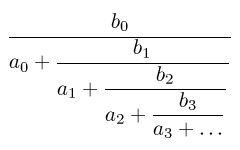This library is intended to help large computations rather then performing individual calculations (in which case you should use a Computer Algebra System like GNU Maxima). Of course it is as well intended to be linked with any piece of code that may need it. In order to use it, you must first compile and install the GNU MP Bignum library on your computer.
The library provides the four arithmetic operations on functions of
any kind, represented by the coefficients of their
MacLaurin series expansion. The computation returns exact
results, but remember that for obvious reasons, the functions
always end with some O(xk) term:
![]() For various reasons, the coefficients have been chosen to be
rationals. They are implemented with the mpq_t type of GMP.
For various reasons, the coefficients have been chosen to be
rationals. They are implemented with the mpq_t type of GMP.
The computation is intended to be quick, since speed was a great issue when writing the code. More precisely, the library should almost often be quicker than a Computer Algebra System; it should be much quicker when handling functions with no well-known properties. Of course if you want to compute the division e3x/e2x you can't expect the library to be as efficient as a CAS, since it really doesn't care about noticing that e3x/e2x = ex before computing the coefficients. On the other hand, operations leading to a result that a CAS wouldn't easely simplify will very probably be quicker with the MacLaurin library. For more informations concerning the complexity of the algorithm, have a look at the F.A.Q..
The functions operate on a type called ml_t through a pointer. Thus define the variables with ml_t a,b,c; in your piece of code, and then call the functions with &a, &b, &c like: ml_init(&,12); ml_init(&b,12); ml_init(&c,12); We follow here the GMP convention: the first argument of the function will be the result of the computation. Note that when macros expand to some expression, it has to be called with a variable (and not a pointer).
The degree of a ml_t variable is the degree of the highest significant coefficient. Thus 1 + x - 2 x2 + O(x3) has 2 for its degree. This is an important issue when using the functions, since the arrays of coefficient for assigning the values must contain (at least) k+1 values for a degree k. Results are unpredictable when a function uses variables with different degrees (false result, segmentation fault, etc.)
Each ml_t variable has to be initialized before being used. Except for some trivial programs, each variable should rather be cleared after being used for the last time.
expand as the degree (with the highest significant coefficient) of a; this is a macro: be carefull to put the variable in the argument (and not a pointer to it).
expand as the mpq_t coefficient of degree n in a; this is a macro: be carefull to put the variable in the argument (and not a pointer to it).
initialize a with degree n without assigning its value.
free the memory used by a; the variable has to be initialized again if it has to be used again (but of course the current value will be lost).
initialize a and make a copy of d.
initialize a with degree n and assign its value by taking the n+1 mpq_t coefficients in the array d.
initialize a with degree n and assign its value by taking the n+1 mpz_t coefficients in the array d.
initialize a with degree n and assign its value by taking the n+1 unsigned int coefficients in the array d.
initialize a with degree n and assign its value by taking the n+1 signed int coefficients in the array d.
assign the values of a (already initialized) by taking enough coefficients (one more than its degree) in the array d; the function may be chosen according to the desired type of the coefficients.
these functions are similar to the previous ones, except that instead of directly assigning the coefficients of the MacLaurin series expansion, the array d provides rather the vector of successive derivates evaluated at 0. Thus assignation will be simpler in some cases: ex will be defined with {1,1,1,1,1,1} rather than with {1,1,1/2,1/6,1/24,1/120}.
put in res the MacLaurin series expansion of the continued fraction with exactly n partial numerators and denominators
 with a and b being arrays of ml_t.
with a and b being arrays of ml_t.
print the MacLaurin series a by using v for the variable (usually 'x' or 'z') and c for the multiplication symbol (if you use '*' the output will be readable by other software like Pari/GP; if you want a nice output for human eyes you may like to use ' ' or '\0' if you don't want any separation between the coefficient and the variable; any exotic choice is acceptable like '.').
these five functions provide the arithetic operations: addition, opposite, substraction, multiplication, inversion, division. Be very carefull since the two functions ml_inv0 and ml_div0 require the output variable to be different from the denominator in or b (but these functions are more efficient in that case).
This function expands the generating function (being given as two arrays of signed integers, one for the numerator and one for the denominator); coefficient of degree 0 in the denominator must be different from 0. Of course this funtion merely performs a division and the same result could be found with the ml_div function, but this function is very efficient when many coefficients have to be computed from a generating function with relatively small degrees in the numerator and in the denominator.